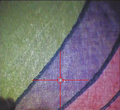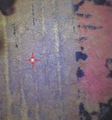Glossary of Ukiyo-e Colorants
TEST
1778-1794 (19-35 yrs old) :As Katsukawa Shunro until he leaves the Katsukawa school. Wide variety, from actor prints, book illustrations, toy prints, meisho, religious, etc.
- Hokusai, Chinese Boys Pulling a Cart, 21.10201
- Hokusai, Chinese Boys Pulling a Cart, 11.15012
- Hokusai, Watching Fireworks in the Cool of the Evening at Ryôgoku Bridge, 21.10202
- Hokusai, The Story of Minamoto Yoshitsune and Jôruri-hime, 11.17572
- Hokusai, Perspective Picture of the Downhill Attack at the Battle of Ichinotani, RES.50.37
- Hokusai, Newly Published Perspective Picture: One Hundred Ghost Stories in a Haunted House, 46.1417
- Hokusai, Urashima Tarô Visits the Dragon Palace, 11.17547
- Hokusai, Woman, Child, and Man with Kite, from the series A Collection of Dances, 11.16764
- Hokusai, Woman Buying Songbirds, from the series A Collection of Dances, 11.16773
- Hokusai, The Night Attack in Act XI of Chûshingura, 11.17612
- Hokusai, The Night Attack in Act XI of The Storehouse of Loyal Retainers, 11.17690
- Hokusai, The Night Attack in Act XI of The Storehouse of Loyal Retainers, 11.17691
- Hokusai, Actor Segawa Kikunojô III as the Courtesan Umegawa, 11.2216
- Hokusai, Actors Ichikawa Monnosuke II as Akaneya Hanshichi and Yamashita Mangiku as Sankatsu, 54.229
- Hokusai, Actors Sawamura Sôjûrô III as Soga no Jûrô and Iwai Hanshirô IV as Oniô’s Daughter Okuni, 06.1271
- Hokusai, Actor Ichikawa Omezô I as the Shamaness, 21.10216
- Hokusai, Actor Sakata Hangorô III as a Traveling Priest, actually Chinzei Hachirô Tametomo, 21.10199
- Hokusai, Actor Sakata Hangorô III as a Traveling Priest, actually Chinzei Hachirô Tametomo, 11.19925
- Hokusai, Actor Matsumoto Kôshirô IV as Banzui Chôbei, 21.10200
- Hokusai, Actor Sakata Hangorô III as Akazawa Jûnai, 21.10198
- Hokusai, Actor Segawa Kikunojô III as Sadaka, 06.801
- Hokusai, Actor Ichikawa Ebizô as Kagekiyo, 06.1061
- Hokusai,
- Hokusai,
- Hokusai,
- Hokusai,
1794-1804 (35-45 yrs old):As Sori produces lots of surimonos and illustrations for poetry books. In 1798, he changes to Hokusai Tokimasa which denotes his independence from any school style. But overall until 1804 his style is considered Sori style (Rinpa).
- Hokusai, Courtesan and Kamuro with Hagoita, 11.20410
- Hokusai, An no Heibei with a Courtesan, from an untitled series of the Five Manly Men, 11.16854
- Hokusai, Hotei Ichiemon with a Courtesan, from an untitled series of the Five Manly Men, 11.16870
- Hokusai, Kaminari Shôkurô with a Courtesan, from an untitled series of the Five Manly Men, 11.19684
- Hokusai, Yoritomo's Camp in the Foothills of Mount Fuji, 11.19662
- Hokusai, Ferry Boat, 11.19657
- Hokusai, Court Lady with New Year Decorations, from the series Comparison of Beauties for the Year of the Goat, 11.25199
- Hokusai, Women and Children Returning from an Inari Shrine Festival, 11.19636
- Hokusai, Two Women with a Koto, from the series Five Great Powers, 11.30481
- Hokusai, Tea Ceremony, from the series Thirty-six Assorted Arts, 53.2718
- Hokusai, Man, Woman, and Child Preparing a Votive Banner at New Year, 53.2673
- Hokusai, Twilight at Sensô-ji Temple, Asakusa (Sensô-ji no iriai), from the book Ehon Sumidagawa ryôgan ichiran, 21.9230
- Hokusai, Woman Looking at Kite with Picture of Bell (Parody of Musume Dôjô-ji), from the series A Collection of Dances, 11.16824
- Hokusai, Women with Theatrical Costumes, from the series A Collection of Dances, 11.19683
- Hokusai, Flower Ball (Kusudama) and Bamboo Blind, 21.7872
- Hokusai, Kanaya, from an untitled series of the Fifty-three Stations of the Tôkaidô Road, 11.16890
- Hokusai,
- Hokusai,
- Hokusai,
- Hokusai,
1804-1811 (45-52 years old): Mainly works on book illustrations and paintings. Uses Katsushika Hokusai as well as Taito.
- Hokusai, View of the Inari Shrine at Ôji and Asuka Hill, 21.10204
- Hokusai, Patterns for Collage Pictures (Oshi-e): Kakinomoto Hitomaro and Kikujidô, 11.20198
- Hokusai, Dance of the Gods at the Heavenly Cave part 2, 11.20433
- Hokusai, Dance of the Gods at the Heavenly Cave part 1, 11.20434
- Hokusai, Ôtomo no Kuronushi, from an untitled series of Six Poetic Immortals (Rokkasen) formed by the characters for their names, 11.17496
- Hokusai, Ôtomo no Kuronushi, from an untitled series of Six Poetic Immortals (Rokkasen) formed by the characters for their names, 21.10218
- Hokusai, Exhibition of Flower Arrangements in a Room Overlooking the Sumida River, 11.19658
- Hokusai, Duck, Abalone Shell, and Parsley, 11.16798
- Hokusai, Act VI, from the series The Storehouse of Loyal Retainers, a Primer, 11.17586
- Hokusai, Act V, from the series The Storehouse of Loyal Retainers, a Primer, 11.17588
- Hokusai, Act VII, from the series The Storehouse of Loyal Retainers, a Primer, 11.17604
- Hokusai, Act IX, from the series The Storehouse of Loyal Retainers, a Primer, 11.17643
- Hokusai, Act I, from the series The Storehouse of Loyal Retainers, a Primer, 11.17539
- Hokusai, Act XI, from the series The Storehouse of Loyal Retainers, a Primer, 11.17499
- Hokusai, Act X, from the series The Storehouse of Loyal Retainers, a Primer, 11.17583
- Hokusai,
- Hokusai,
- Hokusai,
- Hokusai,
- Hokusai,
- Hokusai,
- Hokusai,
- Hokusai,
1812-1829 (53-60 yrs old): Starts producing illustration books for artists/students. Uses Iitsu from 1818-1830 when he produces a lot of surimonos.
- Hokusai, Hair Ornaments, 11.20418
- Hokusai, The Plum-blossom Shell (Ume no hana kai), from the series The Poetry-Shell Matching Game of the Genroku Era, 21.9225
- Hokusai, Komagata-dô Temple (R) and Onmaya Embankment (L), from the series A Set of Horses, 21.10240-1
- Hokusai, Komagata-dô Temple (R), Onmaya Embankment (C), and the Hitching Stone (L), from the series A Set of Horses, 54.259-61
- Hokusai, Stone, from the series Three Pictures for a Children's Hand Game, 11.20413
- Hokusai, Actors Ichikawa Danjûrô VII as Asahina and Ichikawa Monnosuke III as Tsukisayo, 11.20417
- Hokusai, Daikoku Lifting Rice Bales, with Chickens, 00.1948
- Hokusai, Ki no Natora and Ôtomo no Yoshio Wrestling, 00.1949
- Hokusai, View of Koshigoe from Shichiri-ga-hama, 21.9224
- Hokusai, View of Koshigoe from Shichiri-ga-hama, 34.327
- Hokusai,
- Hokusai,
- Hokusai,
- Hokusai,
1830-1833 (71-74 yrs old): Produces his well known prints such as landscape, bird and flower prints, etc.
- Hokusai, Ushibori in Hitachi Province, from the series Thirty-six Views of Mount Fuji, 21.5386
- Hokusai, Ushibori in Hitachi Province, from the series Thirty-six Views of Mount Fuji, 21.5363
- Hokusai, Ushibori in Hitachi Province, from the series Thirty-six Views of Mount Fuji, 21.5385
- Hokusai, Ushibori in Hitachi Province, from the series Thirty-six Views of Mount Fuji,
- Hokusai, Kajikazawa in Kai Province, from the series Thirty-six Views of Mount Fuji, 21.6775
- Hokusai, Kajikazawa in Kai Province, from the series Thirty-six Views of Mount Fuji, 21.6773
- Hokusai, Kajikazawa in Kai Province, from the series Thirty-six Views of Mount Fuji, 21.6774
- Hokusai, Kajikazawa in Kai Province, from the series Thirty-six Views of Mount Fuji,
- Hokusai, Under the Wave off Kanagawa, also known as the Great Wave, from the series Thirty-six Views of Mount Fuji, 06.1153
- Hokusai, Under the Wave off Kanagawa, also known as the Great Wave, from the series Thirty-six Views of Mount Fuji, 06.1283
- Hokusai, Under the Wave off Kanagawa, also known as the Great Wave, from the series Thirty-six Views of Mount Fuji, 06.2548
- Hokusai, Under the Wave off Kanagawa, also known as the Great Wave, from the series Thirty-six Views of Mount Fuji, 11.17652
- Hokusai, Under the Wave off Kanagawa, also known as the Great Wave, from the series Thirty-six Views of Mount Fuji,
- Hokusai, Under the Wave off Kanagawa, also known as the Great Wave, from the series Thirty-six Views of Mount Fuji, 21.6765
- Hokusai, Under the Wave off Kanagawa, also known as the Great Wave, from the series Thirty-six Views of Mount Fuji, 34.317
- Hokusai,
- Hokusai,
- Hokusai,
- Hokusai,
- Hokusai,
1834-1849 (75-90yrs old): Concentrates on paintings. Uses the Manji
Unknown
- Hokusai, Procession of a Daimyô Passing Shinagawa on the Way to Kyoto, 21.10203
- Hokusai, Fan Kuai and the Banquet at Hongmen, 11.14710
- Hokusai, Ladies Trading With a Peddler of Cosmetics and Accessories, 11.19659
- Hokusai, Susaki, from the series Three Shrines of the Goddess Benten, 11.20451
- Hokusai, Female Poet, from the series Five Poetic Immortals, 11.20419
- Hokusai, Nobleman and Attendants Watching the Sunrise, 21.7871
- Hokusai, Agemaki, Sukeroku, and the Sake Vendor at New Year, 53.2674
- Hokusai, Woman Cleaning Fish as Another Woman Reads a Book, 53.2717
- Hokusai, Ôkuninushi no Mikoto, the White Hare of Inaba, and the Crocodiles, 21.9245
- Hokusai, Toys: Bird Whistle, Rattle, Boy Doll with Hobbyhorse, 11.20411
- Hokusai, Fish, Flowers, and Telescope, 11.20408
- Hokusai, New Year in the Yoshiwara, 21.9223
- Hokusai, Eggs and Taro Roots, 11.16760
- Hokusai, Box and Tray of Paper, with Gift Decorations, 11.16766
- Hokusai, Ferry Boat Passing Bridge Pillar, 11.20445
- Hokusai, The Jewel River of Bush-clover (Hagi), at Noji in Ômi Province, from the series Fashionable Six Jewel Rivers, 11.20453
- Hokusai, The Kyôgen Play Utsubo Zaru, 11.19635
- Hokusai, Courtesan, Guest, and Pet Monkey, 21.9222
- Hokusai,
- Hokusai,
- Hokusai,
- Hokusai,
- Hokusai,
- Hokusai,
- Hokusai, test
- Hokusai, test1
- Hokusai, test2
Glossary of Colorants
The purpose of the ukiyo-e (Japanese woodblock) colorant database is to document the types of colorants that were used in the printing process. In order to do this, we started the research by making reference samples of the known Ukiyo-e colorants by traditional Japanese woodblock printing techniques. This database currently focuses on prints from the MFA’s collection especially from 1710-1850. We hope to continue adding to the database but at this moment covers only the colorants found in the above mentioned time frame so does not yet cover the whole breadth of colorants, especially the synthetic one that were added in the second half of the nineteenth century.
Red
The primary organic red colorants used in the prints are: -Safflower -Madder -Sappanwood
Yellow
Orpiment, turmeric and flavonoid yellows (such as pagoda tree, rice plant) are the most commonly used yellow colorants that were easily detected. Gamboge is also likely to have been used but none of the MFA analysis techniques could detect gamboge. Additionally there is literature that points to the potential use of other organic yellows, such as yellowwood, but this has not been found in any of the prints so far.
Of the primary yellows, orpiment (arsenic sulfide) was detected by the X-ray fluorescence analysis. Turmeric and yellowwood both fluoresce very brightly in ultraviolet light and, luckily, give very distinctive EEM spectra (shown below). Some of the other organic yellows, like pagoda tree and rice plant, but fluoresce weakly in ultraviolet light. Chemically, these two compounds are both flavonoids and and only have slight differences in their EEM plots. Thus, the decision was made to call them by their chemical name, Flavonoid, to minimize mistakes in identification.
Blue
Until the introduction of Prussian blue, indigo and dayflower were the only blues used. These blues can easily be identified using FORS. -Indigo -Dayflower -Prussian blue
Green
Green is created as a mixture or overprinting of a blue and yellow. -Indigo/orpiment -Other combinations (List maybe just the common ones and other could be Others)
Purple
Purple is created as a mixture or overprinting of a blue and red/pink. -Safflower/dayflower -Madder/dayflower -Other combinations
Brown
-hematite -red lead -mixtures --faded purple
White
White is often used in a mixture rather than on its own, allowing for the paper to be the “white” -calcium carbonate -white lead
Black/Gray
Carbon black, sumi, or soot from oil lamps or pine soot mixed with animal glue is used to print the key block as well as any other black area. It can range from a deep black to a blue grey color (pine soot).
Mica
description
Metallic
Description
















